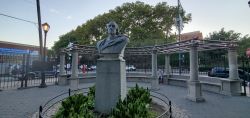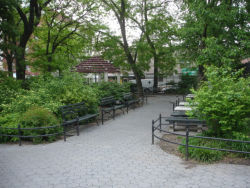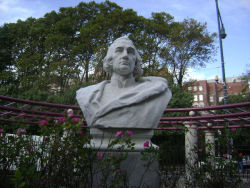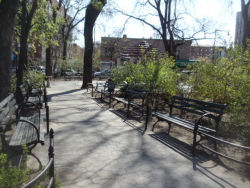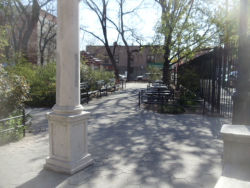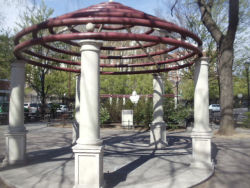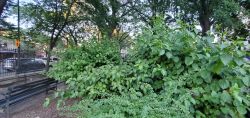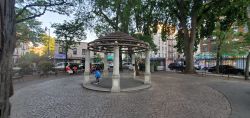D'Auria-Murphy Triangle
Columbus Statue
In 1473, Christopher Columbus (1451–1506) embarked on his first maritime voyage from his home near Genoa, Italy headed for the island of Khios in the Aegean Sea. Upon his return in 1476, he traveled in a convoy destined for England. Legend has it that pirates sunk Columbus’s ship near the coast of Portugal. Columbus swam to shore and settled in Lisbon, where his brother Bartholomew worked as a cartographer.
Based on speculative maps, Columbus concluded that there was a quicker route to the markets of Asia than was yet known. Instead of heading south and circumnavigating Africa, Columbus proposed to sail west. In the 1480s, Columbus presented this proposal to the monarchs of Portugal and Spain. In April 1492, King Ferdinand V and Queen Isabella of Spain agreed to sponsor Columbus’s proposed voyage. On August 3, 1492, the three modest ships that comprised Columbus’s party, the Nina, the Pinta, and the Santa Maria, set sail. They sighted land on October 12, 1492. The ships landed on Guanahani, an island in the Bahamas. Columbus claimed the land for the King of Spain and renamed the island San Salvador. Believing he had reached the West Indies, Columbus called the natives “los Indios,” or Indians. The members of the expedition returned to Spain triumphantly on March 15, 1493. After receiving a title of nobility, Christopher Columbus immediately launched a larger expedition. On November 3, 1493, this fleet of 17 ships anchored near present day Puerto Rico. His third and fourth voyages set sail in 1498 and 1502.
Columbus's early descriptions of the Americas, as in his “Letter to Luis de Santangel Regarding the First Voyage” (1493), liken the land to an earthly paradise brimming with potential for European colonists. By the time that he sent his “Letter to Ferdinand and Isabella Regarding the Fourth Voyage” (1503), he had been undone by political charges against him, several mutinies, and the realities of his colonizing mission. He died impoverished in Spain in 1506 with his public reputation in tatters. Later, when Americans looked for founder-heroes in the early years of the republic, authors like Washington Irving (The Life and Voyages of Christopher Columbus (1828) documented Columbus’s story. Focusing largely on his arrival in the Americas as opposed to the colonization of the area, Irving and others enshrined Columbus as a hero. His popular reputation ever after became that of the bold, courageous adventurer who enabled American civilization, and he is memorialized here and elsewhere as such.
The City acquired the land for this small park in 1931 and it was named for two local men who lost their lives in combat during World War I. Parks redesigned and renovated D’Auria Murphy Park in 1992, installing this marble portrait bust crafted by the Bronx-based sculptor and carver Attilio Piccirilli (1866-1945) in the process. Carved in 1925, the bust was originally located in the schoolyard of P.S. 45 at Bathgate Avenue and East 189th Street.
Piccirilli was one of six brothers who were master stone carvers. The family emigrated from Italy in 1887 and established a studio in 1893 in the Bronx at 142nd Street and Willis Avenue. Some notable Piccirilli brothers’projects include sculptural carvings for the Maine Monument (1912) in Columbus Circle; Patience and Fortitude (1911), the lions in front of the New York Public Library; the Firemen’s Memorial (1913) at Riverside Drive and 100th Street; Daniel Chester French’s Four Continents (1907) on the United States Customs House (now the Smithsonian’s National Museum of the American Indian) in lower Manhattan, and the statues of George Washington by Alexander Stirling Calder and Hermon Atkins MacNeil which adorn the Washington Square Arch (installed 1914-1918).
This statue is one of five sculptures of Columbus in New York City’s parks. The others are located in Central Park and Columbus Circle in Manhattan, Columbus Square in Queens, and Columbus Park in Brooklyn.
Check out your park's Vital Signs
Clean & Safe
Green & Resilient
Empowered & Engaged Users
Share your feedback or learn more about how this park is part of a
Vital Park System

